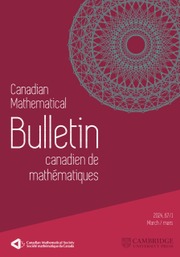Article contents
Expected Norms of Zero-One Polynomials
Published online by Cambridge University Press: 20 November 2018
Abstract
Let  ${{A}_{n}}\,=\,\{{{a}_{0}}+{{a}_{1}}z+\,.\,.\,.\,+\,{{a}_{n-1}}{{z}^{n-1}}\,:\,{{a}_{j}}\,\in \,\{0,1\}\}$ , whose elements are called zero-one polynomials and correspond naturally to the
${{A}_{n}}\,=\,\{{{a}_{0}}+{{a}_{1}}z+\,.\,.\,.\,+\,{{a}_{n-1}}{{z}^{n-1}}\,:\,{{a}_{j}}\,\in \,\{0,1\}\}$ , whose elements are called zero-one polynomials and correspond naturally to the  ${{2}^{n}}$ subsets of
${{2}^{n}}$ subsets of  $\left[ n \right]\,:=\,\{0,\,1,\,.\,.\,.\,,\,n-1\}$ . We also let
$\left[ n \right]\,:=\,\{0,\,1,\,.\,.\,.\,,\,n-1\}$ . We also let  ${{A}_{n,m\,}}\,=\,\{\alpha \left( z \right)\,\in \,{{A}_{n}}\,:\,\alpha \left( 1 \right)\,=\,m\}$ , whose elements correspond to the
${{A}_{n,m\,}}\,=\,\{\alpha \left( z \right)\,\in \,{{A}_{n}}\,:\,\alpha \left( 1 \right)\,=\,m\}$ , whose elements correspond to the  $\left( _{m}^{n} \right)$ subsets of
$\left( _{m}^{n} \right)$ subsets of  $\left[ n \right]$ of size
$\left[ n \right]$ of size  $m$ , and let
$m$ , and let  ${{B}_{n}}\,=\,{{A}_{n+1}}\,\backslash \,{{A}_{n}}$ , whose elements are the zero-one polynomials of degree exactly
${{B}_{n}}\,=\,{{A}_{n+1}}\,\backslash \,{{A}_{n}}$ , whose elements are the zero-one polynomials of degree exactly  $n$ .
$n$ .
Many researchers have studied norms of polynomials with restricted coefficients. Using  $\|\alpha {{\|}_{p}}$ to denote the usual
$\|\alpha {{\|}_{p}}$ to denote the usual  ${{L}_{p}}$ norm of
${{L}_{p}}$ norm of  $\alpha$ on the unit circle, one easily sees that
$\alpha$ on the unit circle, one easily sees that  $\alpha \left( z \right)\,=\,{{a}_{0}}+{{a}_{1}}z+.\,.\,.+{{a}_{N}}{{z}^{N}}\,\in \,\mathbb{R}\left[ z \right]$ satisfies
$\alpha \left( z \right)\,=\,{{a}_{0}}+{{a}_{1}}z+.\,.\,.+{{a}_{N}}{{z}^{N}}\,\in \,\mathbb{R}\left[ z \right]$ satisfies  $\|\alpha \|_{2}^{2}\,=\,{{c}_{0}}$ and
$\|\alpha \|_{2}^{2}\,=\,{{c}_{0}}$ and  $\|\alpha \|_{4}^{4}\,=\,c_{0}^{2}\,+\,2\left( c_{1}^{2}\,+\,.\,.\,.\,+\,c_{N}^{2} \right)$ , where
$\|\alpha \|_{4}^{4}\,=\,c_{0}^{2}\,+\,2\left( c_{1}^{2}\,+\,.\,.\,.\,+\,c_{N}^{2} \right)$ , where  ${{c}_{k}}\,:=\,\sum _{j=0}^{N-k}\,{{a}_{j}}{{a}_{j+k}}\,\text{for}\,\text{0}\le \,\text{k}\,\le N$ .
${{c}_{k}}\,:=\,\sum _{j=0}^{N-k}\,{{a}_{j}}{{a}_{j+k}}\,\text{for}\,\text{0}\le \,\text{k}\,\le N$ .
If  $\alpha \left( z \right)\,\in \,{{A}_{n,m}}$ , say
$\alpha \left( z \right)\,\in \,{{A}_{n,m}}$ , say  $\alpha \left( z \right)\,=\,{{z}^{{{\text{ }\!\!\beta\!\!\text{ }}_{1}}}}\,+\,.\,.\,.\,+\,{{z}^{{{\text{ }\!\!\beta\!\!\text{ }}_{m}}}}$ where
$\alpha \left( z \right)\,=\,{{z}^{{{\text{ }\!\!\beta\!\!\text{ }}_{1}}}}\,+\,.\,.\,.\,+\,{{z}^{{{\text{ }\!\!\beta\!\!\text{ }}_{m}}}}$ where  ${{\beta }_{1}}\,<\,.\,.\,.\,<\,{{\beta }_{m}}$ , then
${{\beta }_{1}}\,<\,.\,.\,.\,<\,{{\beta }_{m}}$ , then  ${{c}_{k}}$ is the number of times
${{c}_{k}}$ is the number of times  $k$ appears as a difference
$k$ appears as a difference  ${{\beta }_{i}}\,-\,{{\beta }_{j}}$ . The condition that
${{\beta }_{i}}\,-\,{{\beta }_{j}}$ . The condition that  $\alpha \,\in \,{{A}_{n,m}}$ satisfies
$\alpha \,\in \,{{A}_{n,m}}$ satisfies  ${{c}_{k}}\,\in \,\{0,1\}$ for
${{c}_{k}}\,\in \,\{0,1\}$ for  $1\,\le \,k\,\le \,n\,-\,1$ is thus equivalent to the condition that
$1\,\le \,k\,\le \,n\,-\,1$ is thus equivalent to the condition that  $\{{{\beta }_{1}},\,.\,.\,.\,,\,{{\beta }_{m}}\}$ is a Sidon set (meaning all differences of pairs of elements are distinct).
$\{{{\beta }_{1}},\,.\,.\,.\,,\,{{\beta }_{m}}\}$ is a Sidon set (meaning all differences of pairs of elements are distinct).
In this paper, we find the average of  $\left\| \alpha\right\|_{4}^{4}$ over
$\left\| \alpha\right\|_{4}^{4}$ over  $\alpha \,\in \,{{A}_{n}}$ ,
$\alpha \,\in \,{{A}_{n}}$ ,  $\alpha \,\in \,{{B}_{n}}$ and
$\alpha \,\in \,{{B}_{n}}$ and  $\alpha \,\in \,{{A}_{n,m}}$ . We further show that our expression for the average of
$\alpha \,\in \,{{A}_{n,m}}$ . We further show that our expression for the average of  $\left\| \alpha\right\|_{4}^{4}$ over
$\left\| \alpha\right\|_{4}^{4}$ over  ${{A}_{n,m}}$ yields a new proof of the known result: if
${{A}_{n,m}}$ yields a new proof of the known result: if  $m\,=\,o\left( {{n}^{1/4}} \right)$ and
$m\,=\,o\left( {{n}^{1/4}} \right)$ and  $B\left( n,\,m \right)$ denotes the number of Sidon sets of size
$B\left( n,\,m \right)$ denotes the number of Sidon sets of size  $m$ in
$m$ in  $\left[ n \right]$ , then almost all subsets of
$\left[ n \right]$ , then almost all subsets of  $\left[ n \right]$ of size
$\left[ n \right]$ of size  $m$ are Sidon, in the sense that
$m$ are Sidon, in the sense that  ${{\lim }_{n\to \infty }}\,B\left( n,\,m \right)/\left( _{m}^{n} \right)\,=\,1$ .
${{\lim }_{n\to \infty }}\,B\left( n,\,m \right)/\left( _{m}^{n} \right)\,=\,1$ .
Information
- Type
- Research Article
- Information
- Copyright
- Copyright © Canadian Mathematical Society 2008
References
- 4
- Cited by

